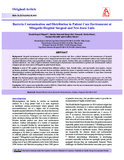| dc.contributor.author | Magori, E. O. | |
| dc.contributor.author | Kang'ethe, S. K. | |
| dc.contributor.author | Muna, Kennedy K. | |
| dc.contributor.author | Revathi, G. | |
| dc.contributor.author | Omuse, G. | |
| dc.date.accessioned | 2021-04-09T12:30:44Z | |
| dc.date.available | 2021-04-09T12:30:44Z | |
| dc.date.issued | 2021-03 | |
| dc.identifier.citation | Annals of Pathology and Laboratory Medicine, Vol. 8, Issue 3, March, 2021 | en_US |
| dc.identifier.uri | https://www.pacificejournals.com/journal/index.php/apalm/article/view/3031 | |
| dc.identifier.uri | http://hdl.handle.net/123456789/4572 | |
| dc.description.abstract | Background: Hospital environment can serve as an important reservoir and thus a critical element in the transmission of bacterial infections especially in critical care settings such as Surgical and new-born units. Contact with contaminated surfaces may lead to Hospital
Acquired Infections (HAIs) among healthcare workers, visitors and patients. Further, HAIs may contribute to the spread of drug-resistant bacterial infections. This study sought to determine bacteriological characteristics and distribution in patient care environmental surfaces (Surgical and new-born units) at Mbagathi hospital Nairobi Kenya.
Methods: A total of 700 samples were obtained from different surfaces: beds, bedside tables, sink taps handle, door handles, nursery incubators, paediatric weighing scale and new-born resuscitation machine by means of repeated screens over a period of three months. Microbiological isolation and identification were done by following standard laboratory methods established at Aga Khan University Hospital. Antibiotic susceptibility testing was carried out by using Vitek 2 system.
Result: Five bacterial genera were isolated, S. Aureus was 3% (19/700), E. coli 0.9% (6/700), Acinetobacter species was 1.4% (10/700), Pseudomonas species 0.1% (1/700) and coagulase negative staphylococcus (CoNS)13.0% (88/700). Trimethoprim/Sulfamethoxazole and Benzylpenicillin were the most resistant antimicrobial agents while Oxacillin, Cefoxitin, Levofloxacin, Linezolid was most sensitive.
Conclusion: All S. aureus were methicillin sensitive (MSSA). Patient beds surfaces were the most contaminated among the selected items while the nursery incubator was the least contaminated. | en_US |
| dc.language.iso | en | en_US |
| dc.subject | Hospital Environment, Bacterial Contamination, Surfaces, Surgical, New-Born Unit | en_US |
| dc.title | Bacteria Contamination and Distribution in Patient Care Environment at Mbagathi Hospital Surgical and New-born Units | en_US |
| dc.type | Article | en_US |

